实验7:基于REST API的SDN北向应用实践
一、实验目的
1.能够编写程序调用OpenDaylight REST API实现特定网络功能;
2.能够编写程序调用Ryu REST API实现特定网络功能。
二、实验环境
1.下载虚拟机软件Oracle VisualBox或VMware;
2.在虚拟机中安装Ubuntu 20.04 Desktop amd64,并完整安装Mininet、OpenDaylight(Carbon版本)、Postman和Ryu;
三、实验要求
(一)基本要求
OpenDaylight
(1) 利用Mininet平台搭建下图所示网络拓扑,并连接OpenDaylight;
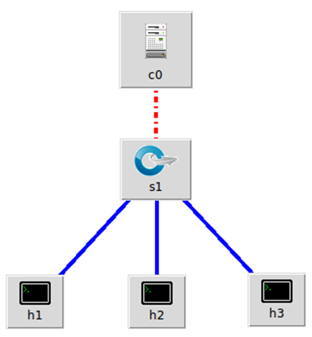
编写Python程序,调用OpenDaylight的北向接口下发指令删除s1上的流表数据
#!/usr/bin/pythonimport requestsfrom requests.auth import HTTPBasicAuthdef http_delete(url):url= urlheaders = {'Content-Type':'application/json'}resp = requests.delete(url, headers=headers, auth=HTTPBasicAuth('admin', 'admin'))return respif __name__ == "__main__":url = 'http://127.0.0.1:8181/restconf/config/opendaylight-inventory:nodes/node/openflow:1/'resp = http_delete(url)print(resp.content)
编写Python程序,调用OpenDaylight的北向接口下发硬超时流表,实现拓扑内主机h1和h3网络中断20s。
#!/usr/bin/pythonimport requestsfrom requests.auth import HTTPBasicAuthdef http_put(url,jstr):url= urlheaders = {'Content-Type':'application/json'}resp = requests.put(url,jstr,headers=headers,auth=HTTPBasicAuth('admin', 'admin'))return respif __name__ == "__main__":url='http://127.0.0.1:8181/restconf/config/opendaylight-inventory:nodes/node/openflow:1/flow-node-inventory:table/0/flow/1'with open('no1.json') as f:jstr = f.read()resp = http_put(url,jstr)print (resp.content)
flowtable.json
{"flow": [{"id": "1","match": {"in-port": "1","ethernet-match": {"ethernet-type": {"type": "0x0800"}},"ipv4-destination": "10.0.0.3/32"},"instructions": {"instruction": [{"order": "0","apply-actions": {"action": [{"order": "0","drop-action": {}}]}}]},"flow-name": "flow1","priority": "65535","hard-timeout": "20","cookie": "2","table_id": "0"}]}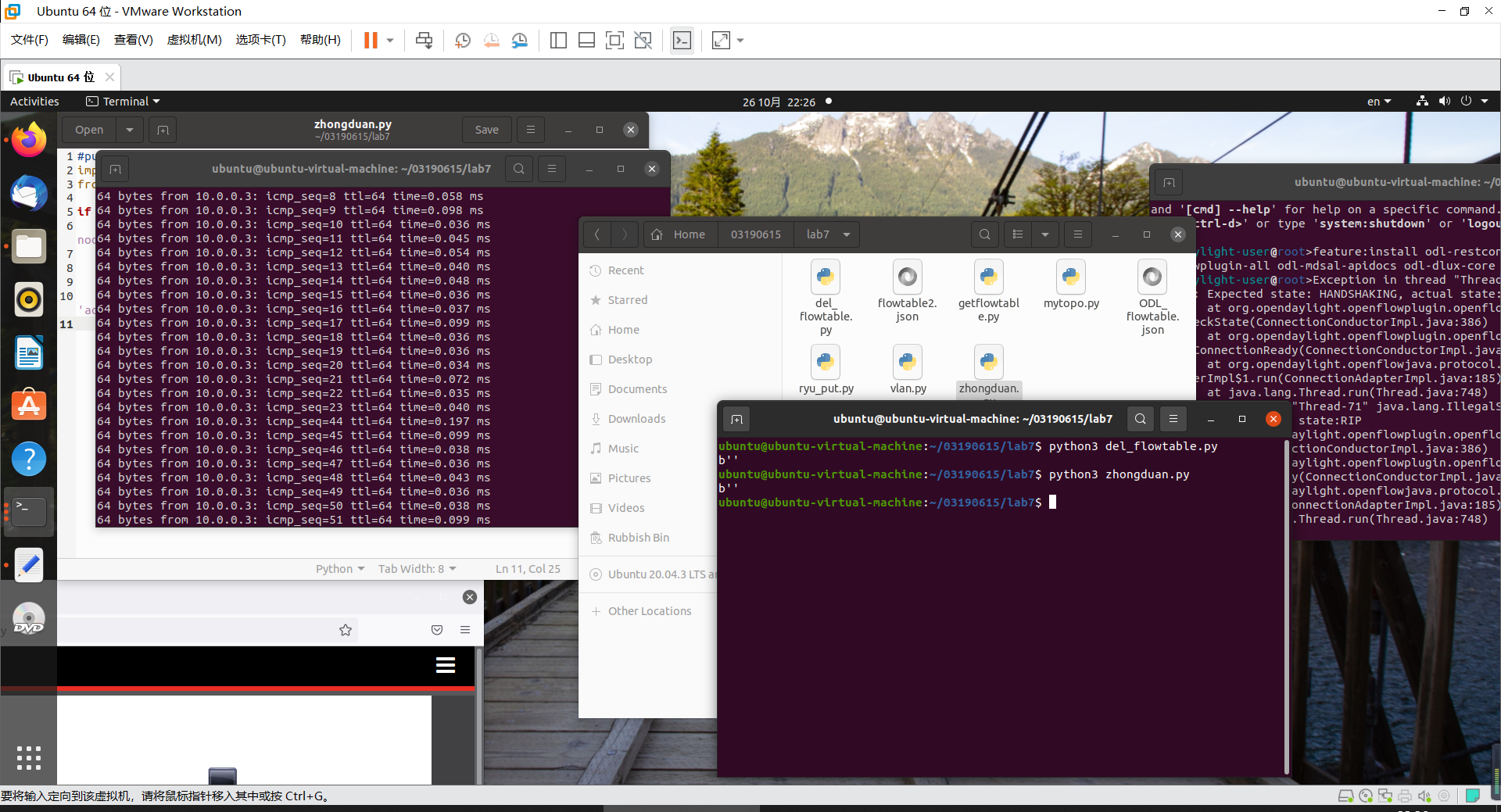
编写Python程序,调用OpenDaylight的北向接口获取s1上活动的流表数。
#!/usr/bin/pythonimport requestsfrom requests.auth import HTTPBasicAuthdef http_get(url):url= urlheaders = {'Content-Type':'application/json'}resp = requests.get(url,headers=headers,auth=HTTPBasicAuth('admin','admin'))return respif __name__ == "__main__":url='http://127.0.0.1:8181/restconf/operational/opendaylight-inventory:nodes/node/openflow:1/flow-node-inventory:table/0/opendaylight-flow-table-statistics:flow-table-statistics'resp = http_get(url)print(resp.content)

Ryu
命令行运行ryu
ryu-manager ryu.app.simple_switch_13 ryu.app.ofctl_rest
(1) 编写Python程序,调用Ryu的北向接口,实现上述OpenDaylight实验拓扑上相同的硬超时流表下发。
#!/usr/bin/pythonimport requestsif __name__ == "__main__":url = 'http://127.0.0.1:8080/stats/flowentry/add'with open("./no2.json") as f:jstr = f.read()headers = {'Content-Type': 'application/json'}res = requests.post(url, jstr, headers=headers)print (res.content)
flowtable.json
{"dpid": 1,"cookie": 1,"cookie_mask": 1,"table_id": 0,"hard_timeout": 20,"priority": 65535,"flags": 1,"match":{"in_port":1},"actions":[]}
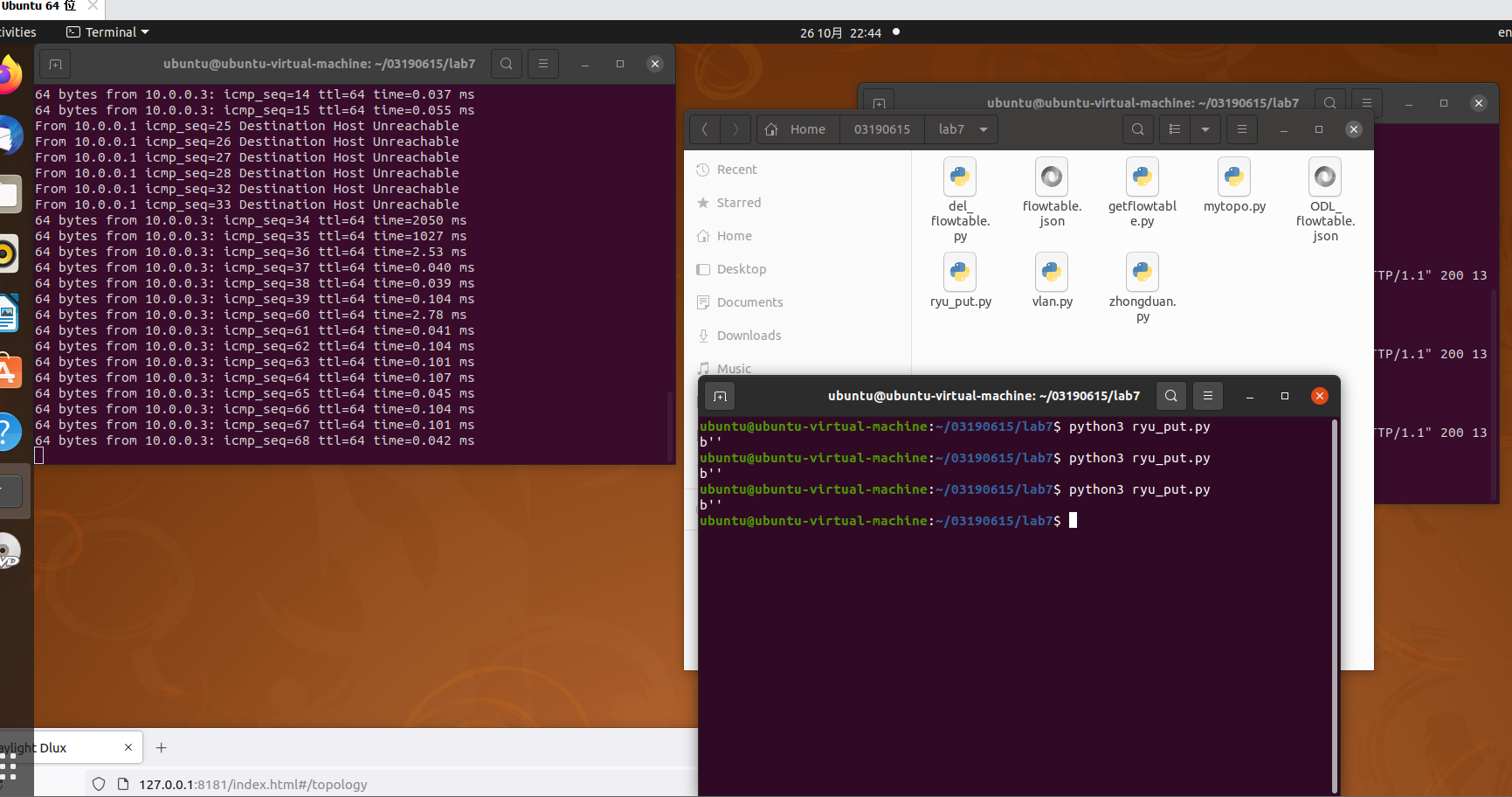
(2) 利用Mininet平台搭建下图所示网络拓扑,要求支持OpenFlow 1.3协议,主机名、交换机名以及端口对应正确。拓扑生成后需连接Ryu,且Ryu应能够提供REST API服务。
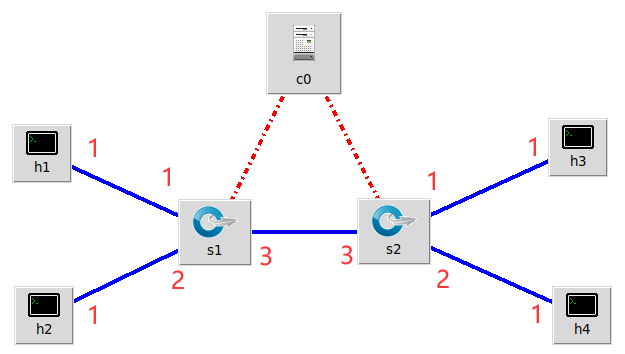
#!/usr/bin/env pythonfrom mininet.topo import Topoclass MyTopo(Topo):def __init__(self):# initilaize topologyTopo.__init__(self)self.addSwitch("s1")self.addSwitch("s2")self.addHost("h1")self.addHost("h2")self.addHost("h3")self.addHost("h4")self.addLink("s1", "h1")self.addLink("s1", "h2")self.addLink("s2", "h3")self.addLink("s2", "h4")self.addLink("s1", "s2")topos = {'mytopo': (lambda: MyTopo())}
命令行运行
sudo sudo mn —custom ryu2.py —topo mytopo —mac —controller=remote,ip=127.0.0.1,port=6633 —switch ovsk,protocols=OpenFlow13
(3) 整理一个Shell脚本,参考Ryu REST API的文档,利用curl命令,实现和实验2相同的VLAN。
| VLAN_ID | Hosts |
|---|---|
| 0 | h1 h3 |
| 1 | h2 h4 |
curl -X DELETE http://localhost:8080/stats/flowentry/clear/1
curl -X DELETE http://localhost:8080/stats/flowentry/clear/2
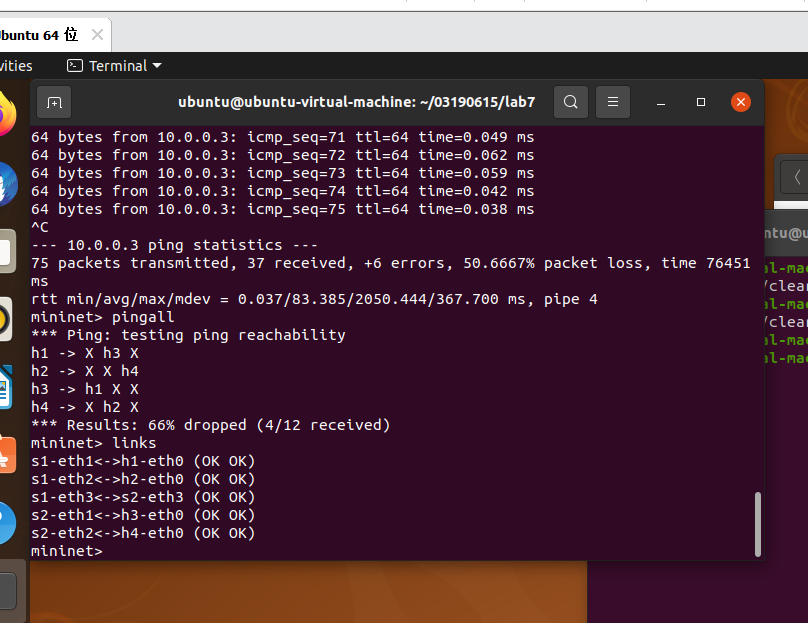
shell.sh
# 将主机1,2发送来的包打上vlan标记curl -X POST -d '{"dpid": 1,"priority": 1,"match":{"in_port": 1},"actions":[{"type": "PUSH_VLAN", # Push a new VLAN tag if a input frame is non-VLAN-tagged"ethertype": 33024 # Ethertype 0x8100(=33024): IEEE 802.1Q VLAN-tagged frame},{"type": "SET_FIELD","field": "vlan_vid", # Set VLAN ID"value": 4096 # Describe sum of vlan_id(e.g. 6) | OFPVID_PRESENT(0x1000=4096)},{"type": "OUTPUT","port": 3}]}' http://localhost:8080/stats/flowentry/addcurl -X POST -d '{"dpid": 1,"priority": 1,"match":{"in_port": 2},"actions":[{"type": "PUSH_VLAN", # Push a new VLAN tag if a input frame is non-VLAN-tagged"ethertype": 33024 # Ethertype 0x8100(=33024): IEEE 802.1Q VLAN-tagged frame},{"type": "SET_FIELD","field": "vlan_vid", # Set VLAN ID"value": 4097 # Describe sum of vlan_id(e.g. 6) | OFPVID_PRESENT(0x1000=4096)},{"type": "OUTPUT","port": 3}]}' http://localhost:8080/stats/flowentry/add# 将主机3,4发送来的包取出vlan标记curl -X POST -d '{"dpid": 1,"priority": 1,"match":{"vlan_vid": 0},"actions":[{"type": "POP_VLAN", # Push a new VLAN tag if a input frame is non-VLAN-tagged"ethertype": 33024 # Ethertype 0x8100(=33024): IEEE 802.1Q VLAN-tagged frame},{"type": "OUTPUT","port": 1}]}' http://localhost:8080/stats/flowentry/addcurl -X POST -d '{"dpid": 1,"priority": 1,"match":{"vlan_vid": 1},"actions":[{"type": "POP_VLAN", # Push a new VLAN tag if a input frame is non-VLAN-tagged"ethertype": 33024 # Ethertype 0x8100(=33024): IEEE 802.1Q VLAN-tagged frame},{"type": "OUTPUT","port": 2}]}' http://localhost:8080/stats/flowentry/add# 将主机3,4发送来的包打上vlan标记curl -X POST -d '{"dpid": 2,"priority": 1,"match":{"in_port": 1},"actions":[{"type": "PUSH_VLAN", # Push a new VLAN tag if a input frame is non-VLAN-tagged"ethertype": 33024 # Ethertype 0x8100(=33024): IEEE 802.1Q VLAN-tagged frame},{"type": "SET_FIELD","field": "vlan_vid", # Set VLAN ID"value": 4096 # Describe sum of vlan_id(e.g. 6) | OFPVID_PRESENT(0x1000=4096)},{"type": "OUTPUT","port": 3}]}' http://localhost:8080/stats/flowentry/addcurl -X POST -d '{"dpid": 2,"priority": 1,"match":{"in_port": 2},"actions":[{"type": "PUSH_VLAN", # Push a new VLAN tag if a input frame is non-VLAN-tagged"ethertype": 33024 # Ethertype 0x8100(=33024): IEEE 802.1Q VLAN-tagged frame},{"type": "SET_FIELD","field": "vlan_vid", # Set VLAN ID"value": 4097 # Describe sum of vlan_id(e.g. 6) | OFPVID_PRESENT(0x1000=4096)},{"type": "OUTPUT","port": 3}]}' http://localhost:8080/stats/flowentry/addcurl -X POST -d '{"dpid": 2,"priority": 1,"match":{"vlan_vid": 0},"actions":[{"type": "POP_VLAN", # Push a new VLAN tag if a input frame is non-VLAN-tagged"ethertype": 33024 # Ethertype 0x8100(=33024): IEEE 802.1Q VLAN-tagged frame},{"type": "OUTPUT","port": 1}]}' http://localhost:8080/stats/flowentry/addcurl -X POST -d '{"dpid": 2,"priority": 1,"match":{"vlan_vid": 1},"actions":[{"type": "POP_VLAN", # Push a new VLAN tag if a input frame is non-VLAN-tagged"ethertype": 33024 # Ethertype 0x8100(=33024): IEEE 802.1Q VLAN-tagged frame},{"type": "OUTPUT","port": 2}]}' http://localhost:8080/stats/flowentry/add
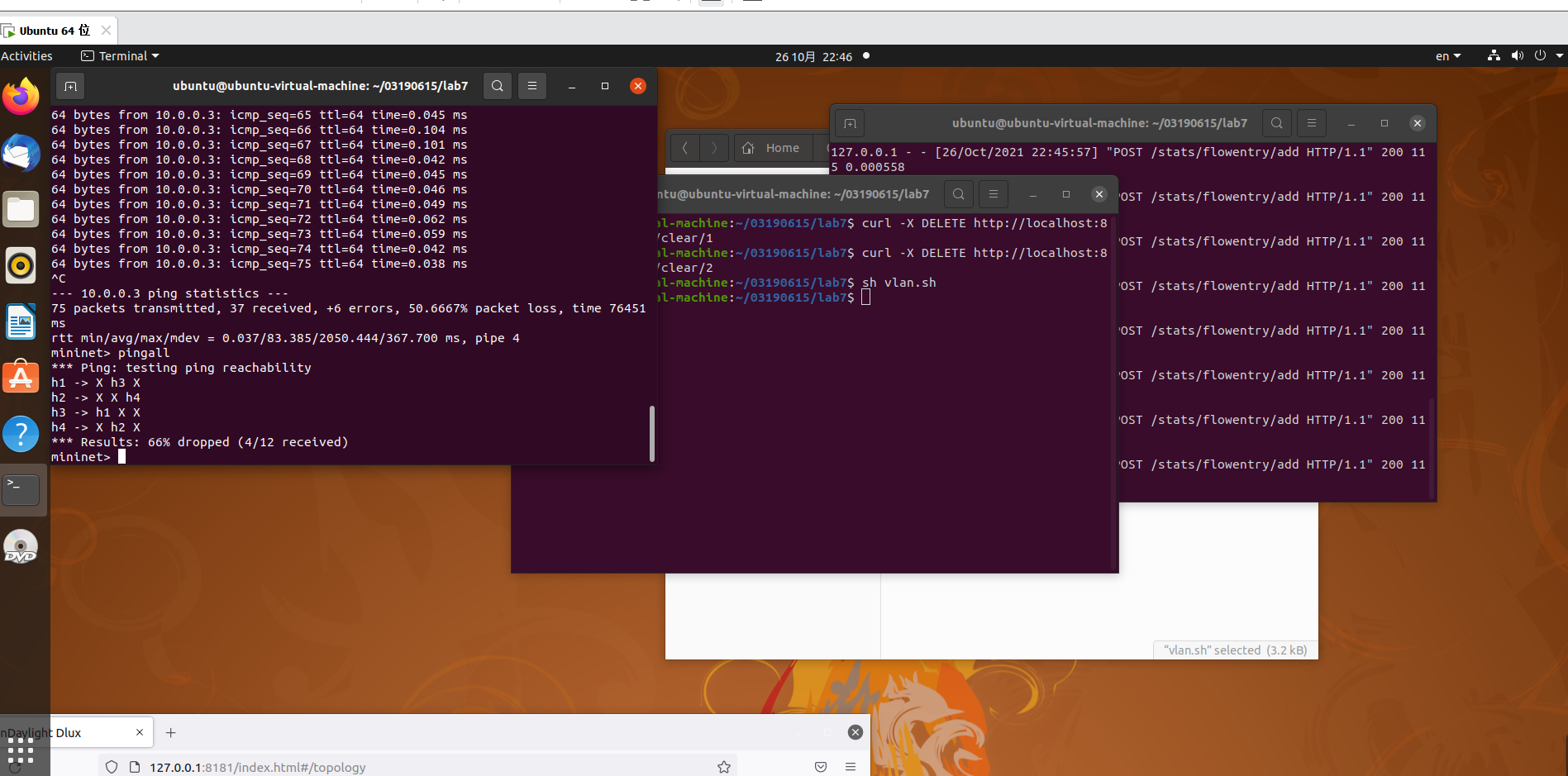
三)实验总结
- 实验难度:本次实验难度较大。
- 遇到的困难及解决办法:
- 运行ryu却无法ping通 老是unreachable 然后,我其他同学告诉我只要一直put命令一直输就可以,最后解决了
- 不知道怎么打开ryu,
- 这次实验收获还是比较大的,学会了ODL和RYU的控制,能够比较熟练的搭建拓扑并且调用所需要的软件工具



